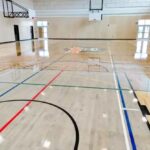Walk into any professional basketball court or high-level gymnasium, and chances are, you’re stepping on maple. This isn’t a coincidence. Maple sports flooring systems are considered the gold standard for a reason. It’s not just about looks—there’s real science behind why maple is the go-to wood for competitive sports.
Hardness That Can Take a Beating
One of the top reasons maple is used in sports flooring is its hardness. On the Janka hardness scale, which measures a wood’s resistance to denting and wear, hard maple scores high. That means it can handle the constant pounding of shoes, equipment, and even the occasional dropped dumbbell.
But here’s the cool part—while it’s tough, it’s not too rigid. Unlike concrete or tile, maple has a little “give” that helps protect joints and muscles. It hits that sweet spot between durability and playability.
Shock Absorption: It’s Easier on the Body
Ever wonder why athletes can train for hours on a maple floor without feeling wrecked afterward? It comes down to shock absorption. Maple naturally absorbs impact better than many synthetic options. This matters big time in fast-paced sports like basketball or volleyball, where players are constantly jumping and pivoting.
Good shock absorption reduces stress on knees, ankles, and hips. That means fewer injuries and longer careers for athletes. For school gyms or rec centers, it means safer spaces for everyone—from kids to weekend warriors.
Grain Pattern That Means Business
Maple’s tight, fine grain isn’t just pretty—it’s practical. The uniform grain pattern makes for a smoother surface that’s consistent across the entire floor. That consistency is key when it comes to things like ball bounce and footing.
Other woods can have uneven grains or soft spots that mess with play. But with maple, you get predictability. Every dribble, every step, feels the same from one end of the court to the other. And when performance is on the line, that kind of consistency is everything.
Why Maple Outperforms Other Species
Some might ask—why not oak or ash? They’re hardwoods too, right? Sure, but they just don’t check all the same boxes.
Oak is strong but has an open grain, which makes it more prone to moisture damage. Ash is flexible but lacks the dense hardness needed for high-impact sports. Maple, on the other hand, brings strength, consistency, and shock absorption all in one. That’s a rare combo.
That’s also why facilities looking for the best sports flooring in the GTA often choose maple over anything else. It’s not just tradition—it’s proven performance.
Maple Sports Flooring Systems: Built for the Long Haul
When you invest in maple sports flooring systems, you’re not just getting a pretty gym floor. You’re getting decades of durability, performance, and low-maintenance upkeep. With proper sealing and refinishing, a maple floor can last for generations.
And thanks to technological upgrades, today’s maple systems come with features like subfloor cushioning, moisture barriers, and precision leveling. These improvements make maple flooring even more adaptable to modern athletic needs.
Wrapping It Up
There’s real science behind why maple is the king of sports flooring. It’s tough, shock-absorbent, and ridiculously consistent. Whether you’re managing a school gym, a professional court, or a community center, maple flooring is a smart choice for both performance and safety.
So if you’re hunting for the best sports flooring in the GTA or planning a high-end athletic facility, don’t overlook the powerhouse under your feet. Maple isn’t just a tradition—it’s engineered for excellence.

